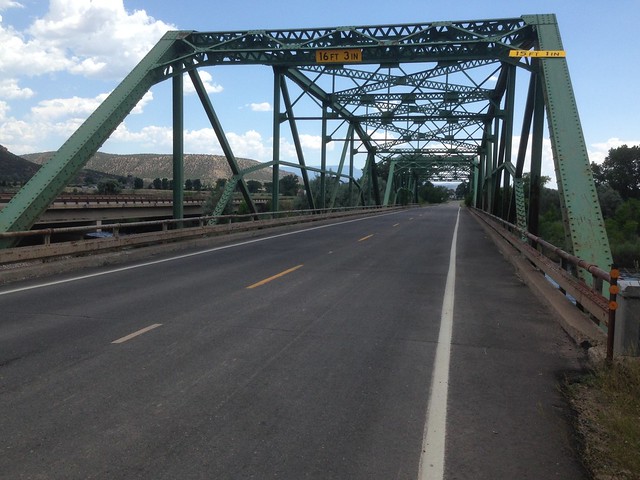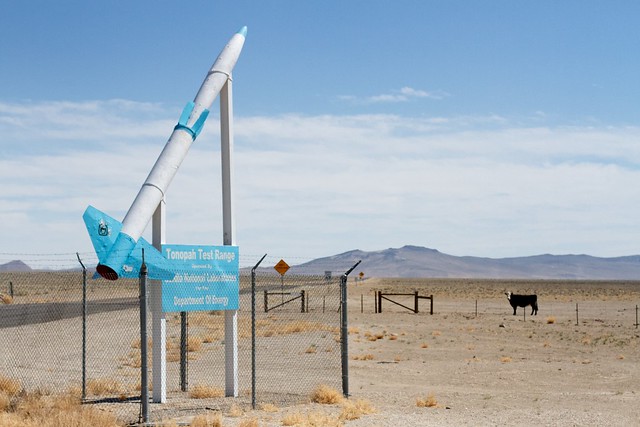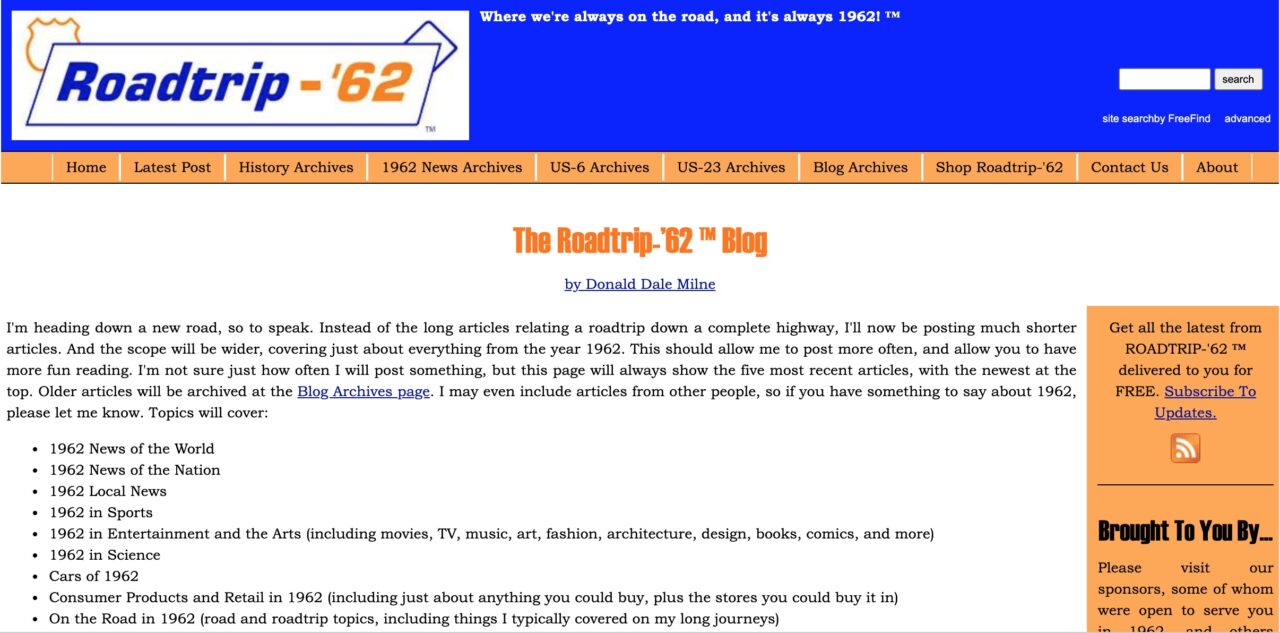I don’t care if it’s just me, but the things that make the web so wonderful in a Keep Austin weird sense are the niche interest sites feverishly maintained by individuals. Coming across a site like Roadtrip-62′ reinforces that, for now, this internet feels as neat to infinite space we can ever freely inhabit.
Like most of me “Woah the Internet is Wonderful” tales, this one is spawned by a flickr photo of mine, as described in this message from Don, who runs the Roadtrip site:
Hello, my name is Don Milne and I operate a website at www.roadtrip62.com devoted to the year 1962, as seen from America’s highways. One of my virtual roadtrips covers highway US-6 through DeBeque, Colorado. I encourage you to check out my progress. I just wanted to let you know that I have used one of your photos, per your Creative Commons License, on my newest page at http://www.roadtrip62.com/us-6-day-32-glenwood-springs-co-green-river-ut.htm and I have linked out to your Flickr page. The photo I used is https://www.flickr.com/photos/cogdog/19261563106/. Thank you for providing information of value to my readers.
There was a time when I would try to be all Educational Mr Smarty Pants, and explain to people that they did not need to ask permission (Don’s email is not doing that, but many of my flickr messages do ask permission to use Creative Commons licensed images). One person blew some clear air my way when they responded something like:
Yes I know about Creative Commons. I just thought maybe you would like to know where your photo was used.
I owe that person a boat load of gratitude.
If you just do the minimum, and follow the letter of the Creative Commons License, for a CC-BY (Attribution) image, someone reusing my photo does not have to notify me. The idea is to reduce the friction of sharing.
That is the bare minimum of compliance. How often is it a notable achievement to reach the level of bare minimum compliance?
When people follow the letter of the CC-BY license, that’s a good thing, but when they take the extra step to let me know, well then I get some idea where my stuff appears. And, as in this case, I often end up down a row of the internet stacks I might have never seen before.
What is Roadtrip-’62? It’s one person’s (Don) mission to provide a web-based time travel back to the year 1962 through virtual road trips.
First, I suppose you’re wondering why ROADTRIP-’62 ™ is different from other travel sites? There’s a very simple answer: everybody else travels only in space, but we also travel in time! That’s right, we don’t just go somewhere, we also go somewhen. And the when is 1962. We’ll try to see what’s left today from 1962, by driving as if it were 1962. We will drive on highways as they were in 1962, try to eat only at restaurants that existed in 1962, try to stay only at motels that existed in 1962, try to buy gas and sundries, play the music, see only the sites across America, and just generally live in America as it was in 1962!
What we will do is enjoy the FUN of cross-country driving. And the fun of cross-country travel is all the differences from our everyday life! We’ll talk about politics, food, great inventions, how people lived, television, and more. We’ll get to see some of the people that made our history; that made this country great. We’ll stumble across unexpected pleasures, like one trip I made through Cherokee, North Carolina where I just happened to be in town as the 1996 Olympic Torch procession came through on it’s way to Atlanta, Georgia. You really never know what you’ll find when you travel!
I missed the point Don was a virtual traveler when I first looked at his site. Don’s page that includes one of my photos is part of his trip on Route 6 across central Colorado. Now people know a lot about Route 66 (thanks to the song, and movies), but I did not know that in 1962 Route 6 was the longest continuous highway in the US.
U.S. Route 6 (US 6), also called the Grand Army of the Republic Highway, honoring the American Civil War veterans association, is a main route of the U.S. Highway system. While it currently runs east-northeast from Bishop, California to Provincetown, Massachusetts, the route has been modified several times. The highway’s longest-lasting routing, from 1936 to 1964, had its western terminus at Long Beach, California. During this time, US 6 was the longest highway in the country.
It lost the longest highway prize when California changed it’s highway numbering system shortening Route 6 from and end at Long Beach, and shrinking it reach to Bishop. Ironically, Bishop, California is a place I spent a lot of time doing my fieldwork in the 1980s for my Masters research in Geology. I drove that last stretch of Route 6 many times into town. And never new I was touching the Grand Army of the Republic Highway.
These kind of two line highways dominated the country in the 1960s, before the modern (and mostly drab dull) interstate system was built out. It’s an oddball of a highway, an outlier, as much as Don’s web site is to the algorithmic controlled web of the near future (this quote from Wikipedia):
US 6 does not serve a major transcontinental corridor, unlike other highways. George R. Stewart, author of U.S. 40: Cross Section of the United States of America, initially considered US 6, but realized that “Route 6 runs uncertainly from nowhere to nowhere, scarcely to be followed from one end to the other, except by some devoted eccentric”.
That is totally the kind of road I like best one that goes “from nowhere to nowhere”.
This is my photo that Don found on Flickr. There is nothing in my title or caption that clues it being on Route 6, but I am guessing he found it via the geolocation data in flickr (it was taken with my iPhone, so flickr picked up the geolocation directly from the original photo, meta data is fabulous)

flickr photo shared by cogdogblog under a Creative Commons ( BY ) license
I remember this stop well for a road trip last summer. I was on my way back from a loop trip to Denver, having visited friends in Glenwood Springs. While my mode for most of road time aims to be off the big highway, I had to use Route 70 between Glenwood, and here, at DeBeque, where I turned south to cross over Grand Mesa (another amazing 2 lane highway trip).
This stretch of highway parallels the Colorado River, while still hundred of miles from it’s Grand Canyon incision near where I live, is still a wide river, but is visible from the road. I70 parallels old Route 6, and I had spotted this old fashion bridge, and took a side excursion to check it our before heading south.
So my photo appears there in the middle post of Don’s Day 32, Into the Desert…and Ghost Towns.
Don’s web site, which looks old schoolish web design and might never win a spiffy slick jQuery flashing web framework contest, but his HTML is clean, consistent, and loads quickly. All the photos he uses are clearly attributed and thus shows that he’s done a huge amount of research beyond “googling and snatching”.
And his writing provides all you need to feel like you are traveling this down Route 6 in 1962.
I did some combing through my travels, and can see I have driven that stretch of highway 6 from Nevada into Bishop, and also last March, a part east of Tonapah Nevada

flickr photo shared by cogdogblog under a Creative Commons ( BY ) license
Nevada’s highway 50 gets billing as the Loneliest Road in America, but I can tell you that Route 6, and Nevada State Highway 375 (The Extra Terrestrial Highway) make Route 50 look like a crowded Manhattan pub.

flickr photo shared by cogdogblog under a Creative Commons ( BY ) license
There were spots on this highway where I just stopped the truck, turned off the engine, and explored around for 20 minutes taking photos

flickr photo shared by cogdogblog under a Creative Commons ( BY ) license
Weird highways are what I love, and so are weird web sites.
You can stick to the interstates of the web, driving with everyone else to the Facebook Malls, I will take the weird roads any time I can.
The internet I like is one that runs “uncertainly from nowhere to nowhere, scarcely to be followed from one end to the other, except by some devoted eccentric”.
Top / Featured Image: Screen shot of http://www.roadtrip62.com/



thank you sir i need your help
there is many script to grape all tweets from specific user like this one
https://gist.github.com/yanofsky/5436496
can you please make a bookmarklet from this script or other script you know
Scripts like these need to run from a server, not sure why it need to run from a bookmarklet. And I would hope the scraping is not for some spam-like endeavor. But if you are looking to make a record of someone’s tweets, I would suggest http://tags.hawksey.info
Thanks for the kind words, Alan.
– Don